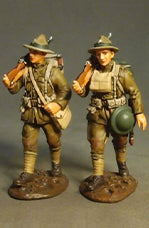16183 - French Royal Deux-Ponts Standing Tearing Cartridge
Couldn't load pickup availability
NEW! IN STOCK!
French Royal Deux-Ponts Standing Tearing Cartridge
The average soldier of the 18th century was expected to fire three volleys per minute. After the first volley, troops usually took from twenty to thirty seconds to reload. Upon loosing the second volley, they would reload and the third volley would occur a minute after the first. Defending troops were expected to release two volleys in the time it would take their enemy to cover a hundred yards
at a dead run. The second volley would hopefully be fired at less than thirty yards when the charging mass of men in tight ranks would have to endure the weight of lead at close range where the musket’s accuracy was greatly increased. The range of 30 yards and less was considered the most effective killing zone for massed firings.
1/30 Scale
Matte Finish
Single Figure in Box







